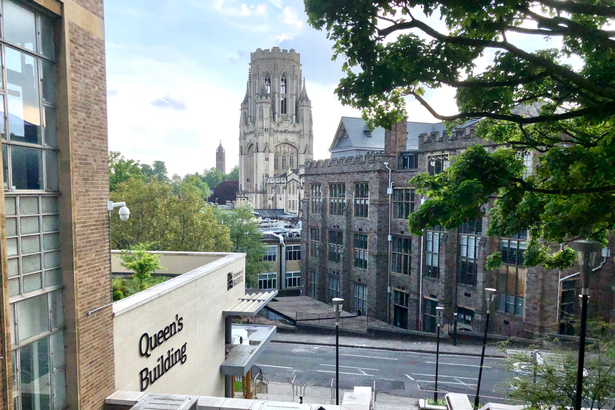The University of Bristol is to set up a £10 million ‘reparations’ fund to tackle racial injustice and inequality, but it won’t be renaming buildings named after people who profited from slavery.
The university will, however, change its logo to remove the dolphin – an emblem associated with Bristol slave trader and merchant Edward Colston.
A wide-ranging announcement today follows a year of consultation and events which saw the university consult with students, staff and the wider community on a whole range of questions. And the establishment of a fund to tackle educational, health and economic inequalities in the city, as well as boost existing projects, like the Black Scholarships Scheme, which looks to help people from ethnic minorities in the city get into university.
Read next: How Bristol challenged Colston for 100 years
Read more: Bristol MPs call for Society of Merchant Venturers to disband
The announcement is the culmination of a process dating back six years to 2017, around the time there was a debate in the city about the concert hall and a number of schools that were named after Edward Colston. A petition was set up by students calling for the name of the Wills Memorial Building to be changed, pointing out that the Wills family made their fortunes from importing tobacco from the US in the 19th century, that had been grown by enslaved people on plantations.
A counter proposal was set up by other students at the time, and the subject was revisited in 2020 when protesters pulled down the statue of Edward Colston, triggering a domino effect that has now led almost all the buildings, businesses and schools named after Edward Colston to be renamed.
In 2022, the university began a consultation process looking at a wide range of issues, including building names and the university’s own logo, as well as the question of whether the university could do more to help black students and the black community in Bristol going forward.
The result is the Reparative Futures programme, with the university saying it will now spend £10 million over the next years to ‘develop a programme that will address racial injustice and inequalities both within the University itself and in the local communities it works with’.
“This will also include presenting the institution’s founders’ historic links to enslavement in a proper context,” they added. “Reparative Futures will build on some of the significant initiatives that are ongoing, and that the University has already invested in over the last few years, such as the Black Scholarships Scheme.

(Image: PAUL GILLIS / Reach PLC)
“In addition, the University will create a community fund for proposals from local groups to work with University of Bristol colleagues on collaborative education and research initiatives that tackle educational, health, and economic inequalities. Partners and experts from ethnically diverse communities will be appointed to support the University’s Reparative Futures programme,” he added.
The vice-chancellor and president of the university, Prof Evelyn Welch has written an open letter explaining the decisions made, and acknowledged that what they are doing won’t please everybody. The open letter is also an apology to ‘those who have experienced racism and racist behaviours at the University of Bristol.
“I would like to thank everyone who took the time to respond to our survey both online and at in-person sessions, including several powerful and impactful events that were led by local Bristol communities of African and Caribbean descent,” she said.
“Throughout, I heard many distressing stories from those who had experienced racism and racist behaviours while engaging with, working at, or studying at the University of Bristol. What began as a consultation on our history and building renaming became a powerful platform to expose deep hurt and frustration with our slow progress and commitment to racial equity,” she added.

(Image: Ben Bloch / Bristol Live)
“I am deeply sorry for these damaging and hurtful experiences which continue to the present day, and I apologise to everyone impacted by those injustices. We aspire to be an inclusive institution and we must do better.
“I know that some of these decisions will not please everybody – but we have listened carefully. We must tell our history in an honest, open and transparent way, while at the same time putting our full weight behind substantive action to address the broader issues of systemic racism and inequality here in Bristol and beyond,” she explained.
The university was founded by three sources of funding in the first decade of the 20th century. The ‘new money’ came from the Wills family, which made its fortune in the 19th century as a tobacco company, along with the Fry family, who became the world’s first mass-producer of chocolate products in the mid-19th century, thanks to cocoa and sugar also grown on plantations.
The third source was the Society of Merchant Venturers, who managed the fortunes amassed by Edward Colston, who died in 1721. A 2018 study commissioned by the university estimated that 85 per cent of the philanthropic funds used for the institution’s foundation was directly connected with the transatlantic slave trade.
The university has decided not to change the names of any buildings named after the likes of the Wills and Fry families, but it will change its logo.
The logo – the most recent of which was created just under 20 years ago – features four emblems: the ship of Bristol, a sun emblem for the Wills family, a horse which was the emblem of the Fry family, and the dolphin, which was the emblem for Colston, and signified the involvement of the Society of Merchant Venturers.
A spokesperson for the University said the institution would: “Retain all current names of buildings, including Wills and Fry, and work with staff, students and the local community to ensure their full stories and historic connections to the University are made visible.
“The Wills and Fry families helped found the university in the early 20th century through substantial financial gifts. While the families did not own or traffic in enslaved people, the products that their 18th and early 19th century predecessors dealt in – such as tobacco, sugar and cocoa -were connected to enslaved labour,” he added.
“The University will work with staff, students, and local communities to ensure the full stories of the institution’s origins, both positive and negative, are made more visible,” he said.
On the removal of Edward Colston’s dolphin emblem, the university spokesperson said: “Colston was a 17th century investor in the slave trade whose statue was toppled into Bristol Docks during a Black Lives Matters protest in 2020. The University received no funding from Colston, who died nearly 200 years before the University was founded, but his personal emblem – the dolphin – formed part of the institution’s crest and modern logo. We will remove the emblem from the logo. The sun symbol of the Wills family and the horse emblem of the Fry’s will remain reflecting the wider decision around retaining building names,” he added.

The university’s announcement made no mention at all of the Society of Merchant Venturers, its role in setting up the university, where its money came from and its continued involvement in running the university today.
There was also no mention in the university’s announcement of the continued presence of Goldney Hall, a halls of residents and ornamental gardens which was built by the Goldney family, who were effectively the link between the ironworks of Staffordshire and the slave traders of Bristol, investing heavily in slave trade voyages, and making the goods which bought the slaves from traders in west Africa.


